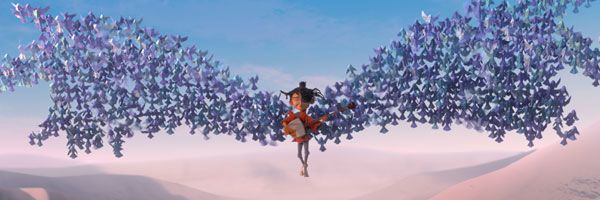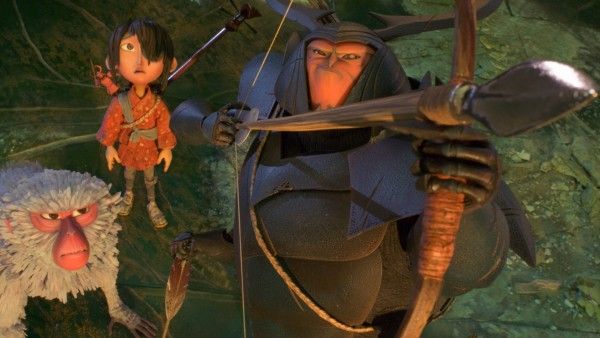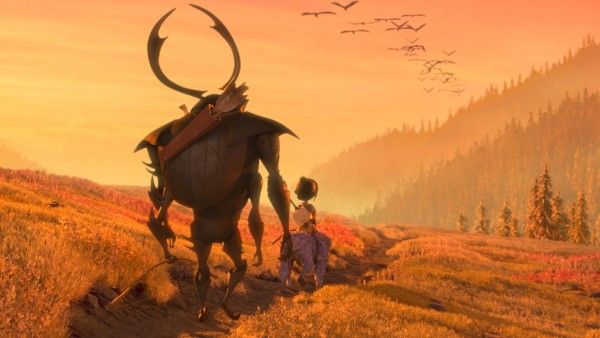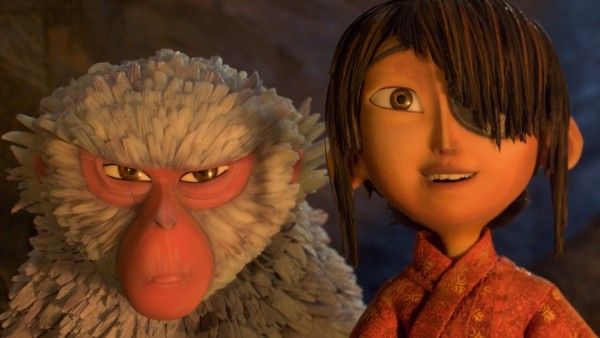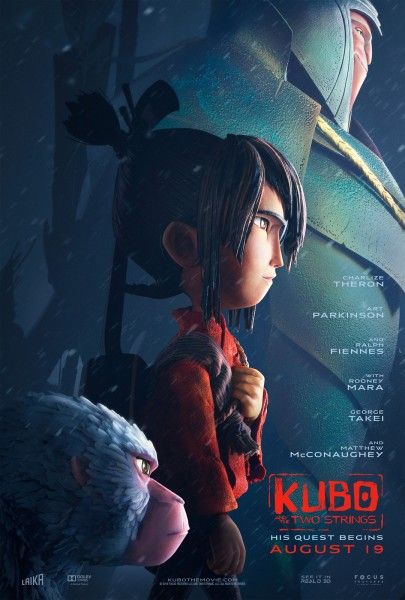“If you must blink, do so now,” Kubo (Art Parkinson) tells us at the beginning of Travis Knight’s Kubo and the Two Strings, Laika’s latest eye-popping stop-motion animated feature. The studio continues to impress as it pushes at the forefront of stop-motion animation, and the visually stunning Kubo is their most gorgeous, incredible work to date. However, as always with Laika, these visuals never come at the expense of the story, and Kubo is their most somber tale thus far as it explores the loss of family and how to tell your own story when you’re afraid of what the future holds. Couched in rich mythology packed with dazzling creativity, Kubo and the Two Strings takes us on a magical journey that you won’t want to miss.
Kubo is a one-eyed young boy who lives in a small village with his sickly mother (Charlize Theron). Kubo has a magical guitar that allows him to control origami, and he uses this gift to perform for the townspeople everyday, but he must return home before the moon rises. One day, Kubo stays out too late and gets discovered by his grandfather the Moon King (Ralph Fiennes), who wants to take Kubo’s other eye. He sends his mother’s wicked sisters (Rooney Mara) after the boy, but with her last bit of strength, Kubo’s mother fends off her sisters and sends Kubo far away with only the aid of Monkey (also Theron), a small totem that has come to life. As Monkey and Kubo trek across the land, they recruit the well-meaning Beetle (Matthew McConaughey), a former soldier in the employ of Kubo’s late father, and the three set off to find a magical sword, armor, and helmet that will help Kubo defeat the Moon King.
The story wears its mythological influences proudly on its sleeve, and it even gets into meta-storytelling as Kubo openly muses about his inability to find an ending to his stories, but this approach helps weave a sense of magic into the very act of storytelling. When Kubo performs for the townspeople, it’s his magic that’s making the storytelling come alive, so even though he’s drawing from archetypes and tropes to tell of an ancient warrior doing battle with great monsters, it’s still entertaining and enrapturing. By the same token, the larger film operates in the same fashion, but it seizes on the importance of storytelling in how we forge our own identity and humanity.
The fascinating conflict in Kubo comes from the fact that the antagonist doesn’t want to kill Kubo, but instead wants to take his eye so that the young boy will be, like his grandfather, blind to humanity. For Kubo and the Two Strings, that’s a fate worse than death, and it gives the film unique stakes despite operating in a familiar mythological structure. The narrative may be about a mismatched group going to retrieve powerful items to defeat an ancient evil, but the heart of the story is in keeping your humanity and how family stays with you even when you think you’re alone.
Unlike Laika’s previous two films, ParaNorman and The Boxtrolls, Kubo is much darker in its thematic musings even though it never completely loses its sense of humor. While it’s not as quirky as ParaNorman or The Boxtrolls, it still maintains a sense of fun, and it’s a movie that’s unafraid to make big asks of its audience like, “This is a monkey totem that has come to life and now speaks with the voice of the hero’s mother,” or “This is a Beetle-man; he’s good with a bow-and-arrow.” If Kubo were a sillier film, these kinds of elements would be commonplace. But because the movie has a deep sense of earnestness, it plays those elements straight, and yet it works because Kubo doesn’t wink at the audience or apologize for its bizarre characters. Kubo and the Two Strings is unabashed world-building at its finest.
Of course, that world building wouldn’t work half as well without Laika’s stunning animation. Just when you think they can’t be any more impressive, they continue to raise the bar with their artistry. While the production design is steeped in Japanese culture (and, to be fair, it would have been nice if they had staffed the cast with Japanese actors), Laika makes their sets feel both ancient and vibrant, combining the two into a mythical realism that makes the story feel larger-than-life and yet tactile and lived-in.
With Kubo and the Two Strings, Laika is now 4-for-4, and they’re easily on par with Pixar at that studio’s height. They’re pushing the boundaries of their medium and doing so with brilliant storytelling that’s captivating for audiences of all ages. Kubo tells us that if have to blink, to do so at the beginning of his tale. I would suggest not blinking at all. You don’t want to miss a moment of Kubo and the Two Strings.
Rating: A

